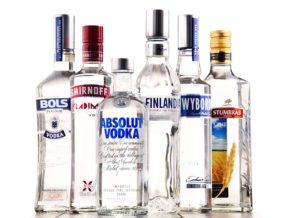Vodka is the backbone of the spirits industry and is easily the most popular spirit in the world. But what is this colorless, flavorless, distilled “firewater?” Where did it come from and why is it so popular?
Vodka originated in Eastern Europe in the 13th century. The word for water in Russian is “voda.” “Vodka” translates roughly from the original Russian to “beloved little water.” Throughout much of Russian history, vodka was tossed back as easily as water, to both warm the body against the brutally cold winters and to soften the hardships of life under the iron fist of the Czar and later of the Soviet government. As an antidote to the daily grind, is there any wonder vodka was, and still is, adored by the Russian people? And now it is loved by the rest of the world as well.
Vodka can be distilled from almost any base material—barley, rye, wheat, corn, potatoes, grapes, and even beets. There are slight variations in flavor, of course. Rye vodka has a slight spiciness to it. Potato vodka can have a lovely creamy quality. Grape based vodka often has a hint of sweetness. All are intended to be colorless and basically flavorless, but quality base materials shine through in the best vodkas and give them character.
The second most important ingredient in vodka is water. Some producers use pure natural water from their springs or rivers. Others use water from melted snow, glaciers, or underground streams. Many companies now use water softeners and filtration methods in their quest for purity.
To create vodka, the base material is mixed with water and fermented to form a sort of beer. This beer is distilled and vodka is the result. Today vodka is produced all over the world including the USA, Russia, Poland, France, Sweden, The Netherlands and many other countries. Vodka can be made simple and pure, as it has been for centuries, or it can be made with a rainbow of spices, fruits, or essences added. Flavored vodkas are here to stay and are favorites of mixologists in creating new and exciting drinks.
The most popular “flavored vodka” is actually what we know as gin. Gin is simply vodka infused with botanicals such as juniper berries and licorice. Other preferred flavored vodkas include lemon, vanilla, chocolate, raspberry, and jalapeno. The highest quality flavored vodkas are made with fresh fruits and spices macerated into the liquor to produce a true essence of the fruit or spice. These are delicious sipped alone or on the rocks. Cheaper flavored vodkas often have an unpleasant “candied” quality and are best blended into cocktails.
The newest vodka on the market is a super-premium vodka out of Asia called Han. Named for the last emperor of the Han Dynasty who supposedly held the secret recipe for this spirit, Han is vodka produced from barley and infused with a polished rice spirit before being filtered through a high-tech micro-quartz freeze filtration system. Han producers claim that Han is will not cause a hangover because all of the impurities have been filtered out. It has a bright clean flavor with hints of sake on the palate. Created in very small batches, Han is marketed as the smoothest vodka in the world.
Whether the vodka you love is super-premium or super cheap, the popularity of vodka continues to surge. If you generally stick to the same brand, branch out a little this year. Set up a vodka tasting with friends to sample different brands that use different base materials at different price points. You’ll be surprised at how diverse the same spirit can taste and might even find a new favorite. As the Russians say, “Na zdorovye!” or “To health!”
Cheers!

Leave a Reply